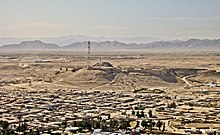Type a search term to find related articles by LIMS subject matter experts gathered from the most trusted and dynamic collaboration tools in the laboratory informatics industry.

In Afghanistan, climate change has led to a temperature increase of 1.8 °C since 1950. This has caused far-reaching impacts on Afghanistan, culminating from overlapping interactions of natural disasters (due to changes in the climate system), conflict, agricultural dependency, and severe socio-economic hardship.
Combined with infrequent earthquakes, climate-related disasters such as floods, flash floods, avalanches and heavy snowfalls on average affect over 200,000 people every year,[1] causing massive losses of lives, livelihoods and properties.[2][3][4][5] These interacting factors, particularly protracted conflicts which erode and challenge the ability to handle, adapt to and plan for climate change at individual and national levels, often turn climate change risks and hazards into disasters.
Although the country itself contributes only very little to global warming with regards to greenhouse gas emissions, droughts due to climate change affect and will affect Afghanistan to a high degree.
Due to a combination of political, geographic, and social factors, Afghanistan is one of the most vulnerable nations to climate change impacts in the world,[6][7] ranked 179 out of 185 countries.[8][9][10] As of 2021, the Asian Development Bank (ADB) has committed more than $900 million,[11] for irrigation and agriculture infrastructure projects to help with food security, agribusiness, and enhancement of water resources management through a climate resilience approach.[12]
Afghanistan is among the lowest emitting countries on earth. In 2018, Afghanistan emitted 0.3 tons of carbon dioxide per capita.[13]
Energy in Afghanistan is reliant especially on hydro-power and solar. Energy is imported as well from neighboring countries.[14][15]
The World Bank projects that Afghanistan will see a warming higher than the global average due to global warming, with rises in maximum and minimum temperatures expected to be higher than rises in average temperature.[19] Since 1950, temperatures in Afghanistan have risen by 1.8 °C.[20] This leads and will lead to massive droughts.[21] Due to these increased droughts related to a warming of all regions of the country by 2.0 °C to 6.2 °C by 2090 depending on scenario, Afghanistan will be confronted with desertification and land degradation.[22] Majority of the country's population is dealing with food insecurity,[23][24] with an increase projected. The increasing droughts could lead to a boom of the opium production in Afghanistan, as opium is drought-resistant.[20]
In addition to droughts, extreme rainfall will increase due to climate change, which could lead to landslides.[25][26]
The basin of the Kunduz River has seen a decrease in precipitation of 30% since the 1960s, which is compensated by increasing glacier melt.[27] Almost 14% of Afghanistan's glacier coverage was lost between 1990 and 2015. By 2100, the region could lose 60% of its glaciers. The number of glaciers and glacial lakes increases in Afghanistan at the moment, probably due to the breaking up of larger glaciers. Mountainous regions such as the area at the source of the Amu Darya will be at great risk of glacial lake outburst floods.[19]
A drought in 2017 and 2018 led to a massive internal displacement within the country.[26] ActionAid claims that by 2050 around 5 million more people could become internally displaced within Afghanistan due to climate change.[26]
Afghan officials claimed in November 2022 that climate change was responsible for losses of more than two billion U.S. dollars in that year alone.[28]

In 2015, Afghanistan submitted a climate plan to the United Nations. The plan outlined that by 2030 at least 2.5 billion U.S. dollars were needed for watershed management and $4.5 billion for restoring irrigation systems.[20]
Taliban officials has lamented the loss of hundreds of millions in aid money for environmental projects since August 2021, protested Afghanistan's exclusion from COP27, and has requested international aid in tackling climate change. The Taliban has argued that the climate crisis is not a political issue.[29][28]
As of 2024, generally the Taliban government thinks that climate change is real, foreign powers are responsible for it and it’s a religious duty to fight it. The Taliban’s environmental policy is largely linked to religion. Some of them fear that climate change is at best a God’s punishment and at worst a sign of the apocalypse. The government has asked imams across all Afghanistan to preach for protecting the environment. According to one of them Farisullah Azhari "Carbon footprints will weigh heavily on judgment day," “God will ask: How did you make your money? And then he will ask: How much suffering did you cause in the process?” The Taliban organized an international climate change conference in Jalalabad, but few guests arrived as Afghanistan remains a global pariah. The isolation cut climate funding, even though the United Nations is still funding some projects. So, the government is mostly confronting the impacts on its own while putting the blame for climate change and weak financial aid on foreigners. It is trying to educate farmers about climate change mitigation and adaptation, like teaching them to keep the grass for it will absorb rain, preserve and build flood barriers as “God won’t help those who don’t take action themselves,”. One villager agreed, but said help is needed.[30]
Medium-range estimates of Arctic carbon emissions could result from moderate climate emission mitigation policies that keep global warming below 3°C (e.g., RCP4.5). This global warming level most closely matches country emissions reduction pledges made for the Paris Climate Agreement...
"The IPCC doesn't make projections about which of these scenarios is more likely, but other researchers and modellers can. The Australian Academy of Science, for instance, released a report last year stating that our current emissions trajectory had us headed for a 3°C warmer world, roughly in line with the middle scenario. Climate Action Tracker predicts 2.5 to 2.9°C of warming based on current policies and action, with pledges and government agreements taking this to 2.1°C.